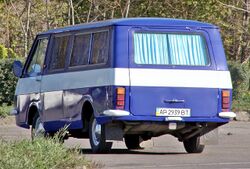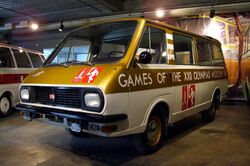Engineering:RAF-2203
Template:Infobox bus The RAF-2203 Latvija (nickname Rafik) was a cabover van designed and developed by Rīgas Autobusu Fabrika from 1976 to 1997. They were widely used throughout the USSR as fixed-run taxis (marshrutkas), medical cars, used for trade and as a special services vehicles. It was the successor of the RAF-977.
This van used the 2,445 cc (149.2 cu in) engine of the GAZ-24, between the front seats, making its construction similar to other competing vans such as the Dodge A100 and the Volkswagen LT, with independent front suspension also from the GAZ-24 (but springs from the GAZ-13).[1] It borrowed headlights and brake system parts from the Moskvitch 412, outside door handles from the Moskvitch 408,[2] and 15 in (38 cm) wheels of the GAZ-21 Volga.[3] The single rear door hinged at the top,[4] rather than the more-usual side-opening. There were two major models: one, the 2203, seated ten plus driver and passenger, powered by a 95 hp (71 kW; 96 PS) 2,445 cc (149.2 cu in) with 8.2:1 compression; the other, the 22032, a twelve-seat "route taxi", had longitudinal seats and lower 6.7:1 compression (to use more readily available 76 octane petrol), and produced only 85 hp (63 kW; 86 PS).[5] (The 2203-02 would run on liquified propane).[6] An ambulance, the 22031, was soon added to the range, and made up fully a third of all 2203s built; there was also a 22035 for blood donor clinics.[7] These were joined by the 22034, for fire departments.[8]

In addition to the uncommon 22033 and 22036 for state militias, there were prototype electric vehicles.[9]
While the 2203 looked good, it was susceptible to rust, especially in the frame rails,[10] and was unpleasant to drive in bad weather.[11] Quality control of the assembly was also poor.[12] Oil leaks and axle bearing failures were frequent.[13] It also suffered overheating, serious vibration issues, failures of front suspension parts leading to poor handling, and high fuel consumption.[14] On top of it all, access to the cab was difficult, despite the forward-control position.[15]
After RAF went bankrupt, production was picked up by GAZ, who quickly replaced it with the GAZelle.[citation needed]
Variants

- RAF-2203 Latvija – 4x2 4dr van, 1976
- RAF-2203 Latvija [delivery] – 4x2 4dr delivery van
- RAF-2203 Latvija [cardiology] – 4x2 4dr cardiac ambulance
- RAF-2203 Latvija [fire] – 4x2 4dr fire minivan
- RAF-2203 Latvija GAI – 4x2 4dr police van
- RAF-2203 Latvija [mail] – 4x2 4dr mail van
- RAF-2203 Latvija [taxi] – 4x2 4dr taxi van
- RAF-2203 Latvija VAI – 4x2 4dr military police van
- RAF-22031 Latvija – 4x2 4dr ambulance
- RAF-2907 – special car based on RAF-2203
Gallery
-
RAF-2203
-
RAF-2203
-
RAF-22031
-
RAF-2915-02
-
RAF-22038
-
РАФ-22038-021
-
RAF-2914
-
RAF-2909
-
RAF-2203 (far right) that was used during the liquidation procedure of the Chernobyl Disaster
-
RAF-2203
-
RAF-2203 1:43 die-cast toy
References
- ↑ Thompson, Andy. Cars of the Soviet Union (Haynes Publishing, Somerset, UK, 2008), p.195.
- ↑ Thompson, p.197.
- ↑ Thompson, p.195.
- ↑ Thompson, p.196 caption.
- ↑ Thompson, pp.195 & 197.
- ↑ Thompson, p.197.
- ↑ Thompson, p.197.
- ↑ Thompson, p.197.
- ↑ Thompson, p.197.
- ↑ Thompson, p.197.
- ↑ Thompson, p.195 caption.
- ↑ Thompson, p.198.
- ↑ Thompson, p.198.
- ↑ Thompson, p.198.
- ↑ Thompson, p.198.
 |











